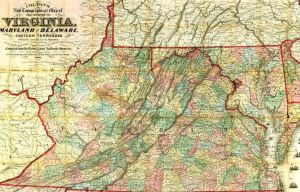 Fires burn brightly through the night, followed by a smoky sunrise over the town of Princeton, (present-day) West Virginia in Mercer County. (At the moment, West Virginia is in the process of official recognition as a state carved out of Virginia.)
Fires burn brightly through the night, followed by a smoky sunrise over the town of Princeton, (present-day) West Virginia in Mercer County. (At the moment, West Virginia is in the process of official recognition as a state carved out of Virginia.)
Princeton lies near the Virginia and Tennessee rail line, and is thus considered strategic by both the North and the South. Federal troops in recent weeks have been advancing upon the railroads in Virginia, driving Confederate troops before them. Yesterday’s skirmish over control of railways had taken place in Princeton when, after a day-long fight, Confederate forces retreated, but not before torching the Southern city to prevent supplies from falling into Union hands. One of the victorious Union regiments was commanded by future President Rutherford Hayes; another future president William McKinley, also fought in the regiment.
The fighting had been fierce, but the smoldering desolation this morning resembles the Christian vision of hell in a land believed to be God’s chosen nation. Left intact are the jail and ten homes. Everything else is rubble and ashes.
Among the charred landscape are the blackened remains of Princeton’s First Baptist Church. Congregational members are bittersweet. Their meeting house is utterly destroyed, but at least the Union army cannot exploit the former facilities for their evil purposes.
The Union hold upon Princeton and Mercer County, however, is tenuous. Two weeks hence, Confederate forces, by then reinforced, manage to drive the federals out in the three day Battle of Princeton Courthouse.
Sources: “Burning of Princeton” (link); “Our Church History,” First Baptist Church, Princeton (link); “Battle of Princeton Courthouse” (link)


